If everyone believes something, then it’s true, right? In the case of decades of escalating real estate prices, booming home construction, commercial build out, jet planes, and traffic jams, many Islanders ascribe the root cause to one person who touched down on the Island thirty years ago this month. That’s former President Bill Clinton, who, accompanied by First Lady Hillary Clinton and daughter Chelsea, transformed the Vineyard into both the summer White House and his playground for eleven days in August 1993. He returned almost every year during the Clinton presidency.
The debate of “did he or didn’t he” ignite the flood of big money and the seeming explosion of so-called trophy houses remains unsettled, though opinions on the question are vivid from all angles. And for good reason.
The arrival of the Clintons was a moment. Hundreds greeted a smaller Air Force One when the First Family touched down that first summer, with hundreds more lining Airport Road lifting homemade signs of welcome. The press corps was staked out in the Edgartown School, yet the Clintons, much to the annoyance of said press, never had a formal schedule. They just took off in the motorcade day and night.

Off they went on a yacht with Jacqueline Kennedy Onassis and to private meals with Carly Simon, William and Rose Styron, and Henry Kissinger. Vernon Jordan, the late Washington, D.C., powerbroker and former head of the National Urban League, golfed so often with Clinton at Farm Neck Golf Club in Oak Bluffs that the pair’s picture was featured in an ad from the club in the Vineyard Gazette that thanked Clinton and Jordan for the memories.
Very quickly the Vineyard learned that Clinton loved wading into a crowd. Linda Jean’s Restaurant in Oak Bluffs was a favorite breakfast stop. There was no call ahead, and before the family settled into a booth they’d stop at every table for a handshake and hello.
National and international press covered and photographed the president’s many excursions, whether it was miniature golf with Chelsea, a tour of the Camp Ground in Oak Bluffs, hunting down an ice cream cone, or hitting the Agricultural Fair in West Tisbury. Their forays were telegraphed far and wide, putting the Vineyard literally on the map.
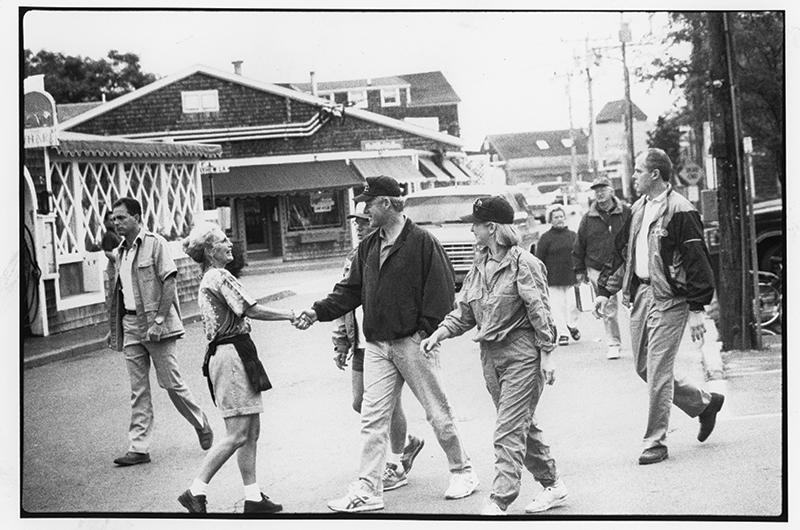
The press descriptions certainly made us sound fancy. UPI, the wire service found in newsrooms nationwide, described the Vineyard as a “trendy resort island, one of the nation’s most elite vacation haunts.”
Celebrity by that point was nothing new to the Vineyard. The miles-long list of residents and visitors included the likes of Thomas Hart Benton, Emily Post, James Cagney, Beverly Sills, Walter Cronkite, Mike Wallace, Art Buchwald, James Taylor, Lillian Hellman, Katharine Graham, Diane Sawyer and Mike Nichols, Carly Simon, Robert McNamara, John Belushi, Bill Murray, Spike Lee, and Jacqueline Kennedy Onassis.
Many more would follow: Princess Diana, Oprah, David Letterman. In 2008, then-President Barack Obama and his family arrived, providing a redux of the Clinton-years fanfare, albeit less frantic and public. Recently, they became Vineyard homeowners after enjoying their own vacations here during their White House years.
Still, the arrival of the Clintons was wholly different than the celebrities who, for the most part, sought out the Vineyard for the privacy it afforded. “Clinton did indeed change the character of the Vineyard, really overnight,” says Sharon Purdy, who owned Sandpiper Realty from 1969 until 2011. “The next season was so very different. No president can hide, and it made international news. Martha’s Vineyard became the found place – the place to go.”
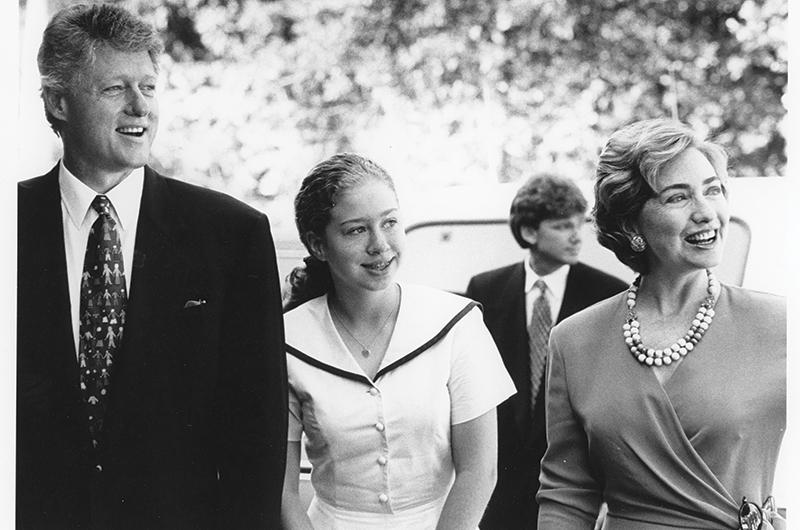
Richard Reston, who now lives in Sarasota, Florida, but was editor and publisher of the Vineyard Gazette from 1975 to 2003, echoes the opinion. “When Clinton arrived, it was like pouring millions of dollars into advertising the place,” he says. “You could see the crowds rise and there began to be a different chemistry in the character of the community. By the nineties, the place was on fire and it was hard to cool it.”
And yet, in many ways, there were glowing embers accumulating long before. By the time the Clintons stepped onto the airport tarmac, development had been booming for more than two decades. The population had exploded, developers were grabbing large chunks of land, and battle lines for the future of the Vineyard were regularly being drawn and redrawn – years before the first presidential motorcade of identical black Suburbans went whizzing past.
All of which begs the question: did the Clintons unwittingly turn the Island into “the place to be,” thereby gradually but surely closing it off more and more to the little guy? Or could it be that our collective memories and shared narrative got it wrong?
George Brush, the founding attorney of his West Tisbury law firm, says he can pinpoint the exact date that ushered in the modern-day Vineyard: July 18, 1969. On that night, then-Senator Edward “Ted” M. Kennedy drove off the Dike Bride on Chappaquiddick after a party, killing twenty-eight-year-old Mary Jo Kopechne. In political shorthand, the date would come to be known simply as “Chappaquiddick.”

The deadly crash was arguably one of the first large-scale events to fall on our shores, says Brush, and opened the nation and the world to the Vineyard. To the horror of Chappy residents, suddenly tourists were making a pilgrimage to the bridge just to see it, touch it, and photograph it. (Later, a different breed of visitors would leave marijuana roaches on John Belushi’s gravestone in Abel’s Hill Cemetery in Chilmark.)
More headlines and attention soon followed. “After that we had James Taylor on the front cover of Time magazine singing the ‘reason I’m smiling is over on the island’ in 1971,” says Brush. A few years later, a young director named Steven Spielberg arrived to film Jaws on the Island, beaming images of Menemsha, Oak Bluffs, Edgartown, and Aquinnah into theaters across the country.
Carly Simon hit and stayed at the top of the charts. Blues Brother John Belushi and Ghostbuster Bill Murray came to the Island and set up camp. And all across the Island, the population of Island residents – not just celebrities – began to explode. From 1970 to 1980, Dukes County was one of the fastest-growing counties in New England. During that same time frame, the residential housing stock rose 60 percent. By 1980, the population of the Island had skyrocketed 46 percent over a decade earlier. It rose another 30 percent in the next decade. This, after hovering around 5,000 to 6,000 year-round residents since 1940. Developers and even corporations began to take notice.
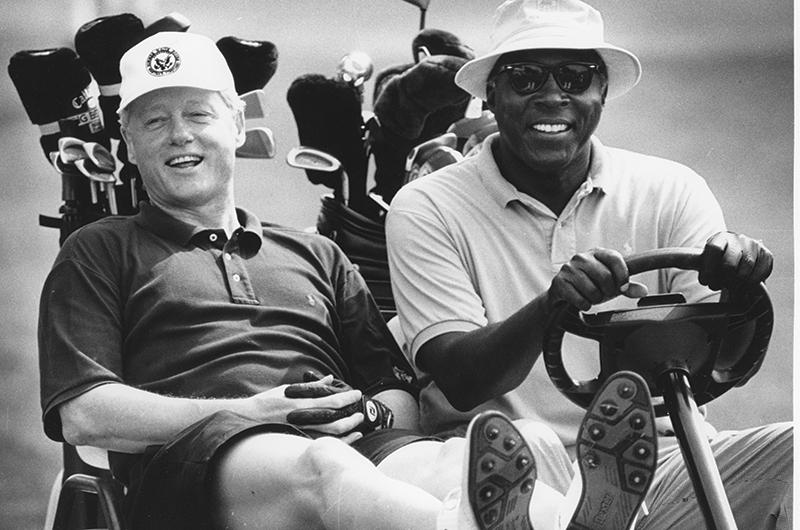
Looking back, Reston recalls notable battles in “the march to Clinton’s time” – a period he, too, says began with the Chappaquiddick tragedy. Among the most memorable: a 1978 fight to bar McDonald’s from the Vineyard, which gained national ink and seemed to signal what was to come. “Through the eighties, the paper was always under the threat of boycotts from developers and commercial operators because of our constant environmental defense that the character of the Vineyard must be preserved,” says Reston.
Even then, concerns about overdevelopment were nothing new. Back in 1969, the actor James Cagney, who had an estate in Chilmark, protested a proposed airport runway expansion and the arrival of jets, asking, “Is there to be no end to the destruction of all that is natural and worthwhile?”
Underpinning all this change was a strengthening economy and an influx of cash, far surpassing anything seen in the Island’s long history of tourism and privacy-seeking celebrities. “[The late West Tisbury historian and author] David McCullough had a phrase, ‘the river of money,’” says Warren Doty, a former Chilmark select board member who stepped down in April after twenty-four years. “We have a river of money that’s laid at our door. And that’s what’s influenced Martha’s Vineyard the most. The tremendous amount of new wealth through hedge funds and high finance and bonus checks that allowed people to buy a summer home.”
That river of money didn’t just wash on Vineyard shores; it also began to transform communities such as Nantucket and the Hamptons, which, by most accounts, have seen an even greater rise in real estate prices and caché than the Vineyard.
“We blame it on the Clintons, but not on Beverly Sills or James Taylor or Walter Cronkite, Carly Simon or Mike Wallace and Art Buchwald,” says Doty. “Walter Cronkite was known as the most trusted man in America, and he had a house in Edgartown. [Katherine] ‘Kitty’ Cornell or James Cagney? Or Alfred Eisenstaedt? We had all those people here.”
In fact, the Gazette files note that Eisenstaedt “used his Leica M4 to take formal black and white photographs of the Clintons” in the summer of 1993.
“I find the causes sort of mysterious but self-perpetuating,” says Linda Sibley, who has sat on the Martha’s Vineyard Commission for more than thirty years. She calls the notion that the Clintons should be in the crosshairs for ushering in widespread change “silly.”
“The more we’re the place to be, the more we’re the place to be. I think the Clintons were a symptom of something, but I don’t know what that something is. We’ve just become too popular for our own good.”
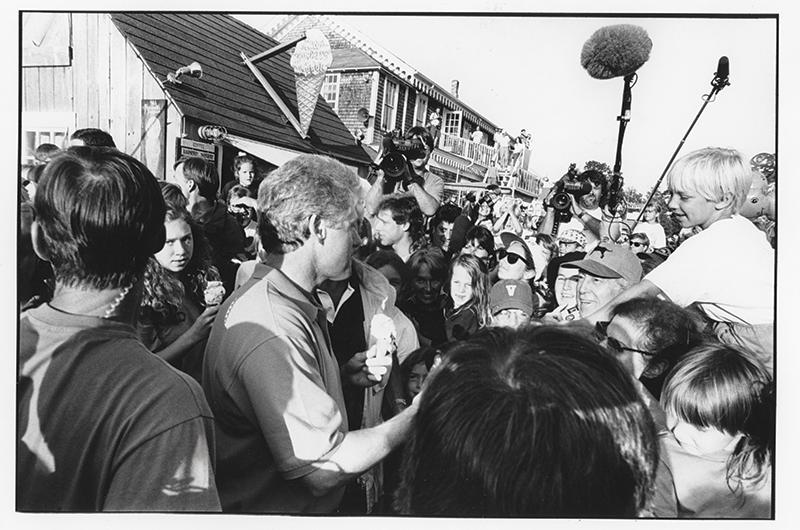
Where, then, does this lingering idea come from that the Clintons are responsible for so much change, and why does it persist?
Other presidents have had notable vacation spots: the Bushes had Kennebunkport, Maine; Ronald Reagan went to Santa Barbara, California; and the Bidens are known to show up on Nantucket. But sweeping changes and escalating real estate prices arrived on that other island long before the Bidens spent the occasional Thanksgiving there. And the Hamptons, which has almost certainly surpassed the Vineyard in wealth and development, isn’t typically associated with presidential retreats – though it has had its share of political candidates swinging through to collect big checks.
Part of the answer to the persistence of the Clinton myth likely lies in just how memorable and unusual their arrival on the Vineyard was in 1993. Change can come slowly, almost imperceptibly, or suddenly. Sometimes it can be both.
“Our business increased, like, tenfold the next season. It was an amazing change,” says Purdy, the former owner of Sandpiper Realty. “A lot more money started coming to the Vineyard and there were many of us who said, ‘This is great for business, but not for the Island.’ And then he never stopped coming.”

Hers wasn’t the only business that saw rapid change. “Farm Neck [Golf Club] became a bigger deal than the Gay Head Cliffs,” says Judy Federowicz of Landmarks at Today Real Estate, who has worked in real estate since 1983.
“Yes, the Clintons marked a certain beginning, but I never viewed it as a negative,” she says. She appreciated that the president and his family ventured out to engage with the community, and seemed to thoroughly embrace their time here. “The Vineyard meant something to them, and they appreciated the much more interesting tapestry we have here.”
Still, we’ve taken our knocks, often from Republicans, following decades of hosting other notable Democrats – from the Kennedys and Robert McNamara to current residents John Kerry and the Obamas. Former President George W. Bush, taking a summer break from clearing brush on his Texas ranch, famously said, “Most Americans don’t sit in Martha’s Vineyard, swilling white wine.”

And then there’s Florida Governor and presidential candidate Ron DeSantis, who thought he’d put a stick in the eye of Northeast liberals by sending planeloads of migrants here last September.
The Clintons are certainly in that mix and helped cement the reputation of the Island as a “playground for the liberal elite.” But what all of it has brought to the Vineyard, and whether it’s a plus or a minus, is a question without a solid answer. It’s a cocktail hour debate, perhaps with that white wine in hand, that will never be resolved.
And why should it be? It’s way too much fun to bat that one around.

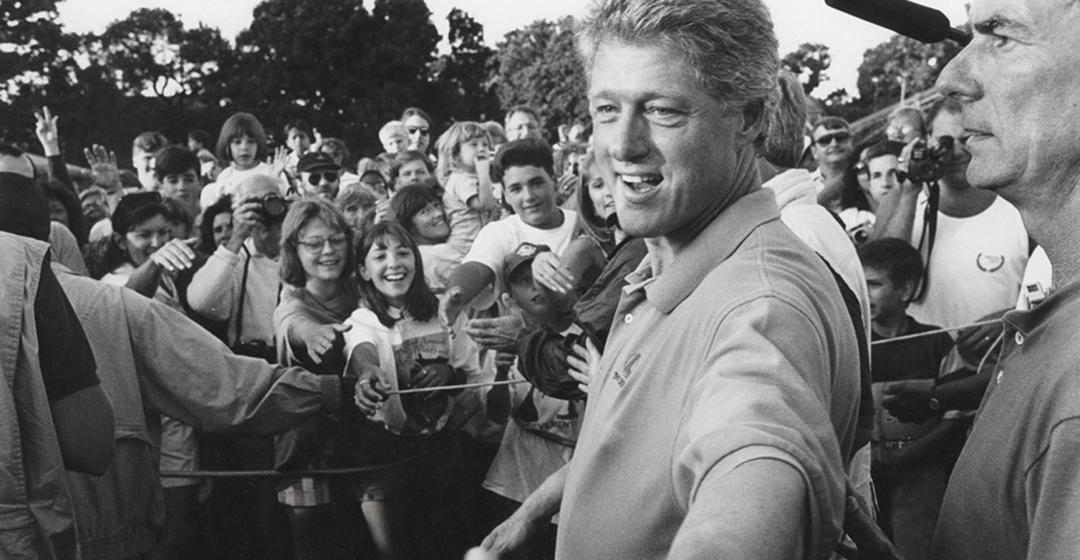


 4 comments
4 comments
Comments (4)